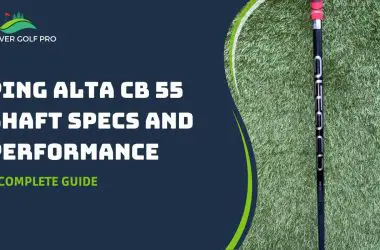The M Flex Taylormade is ideal for senior golfers with slower swing speeds who prioritize distance, forgiveness, and ease of use over precision and shot-shaping capabilities. It suits seniors who maximize their distance off the tee and gain consistency on their shots. However, it may not be the best choice for more experienced or athletic golfers who prefer greater control and shot versatility.
One thing I love about golf is that I can continue to play and be competitive even while I approach my twilight years. For players in this category, there are shaft configurations that allow you to achieve desired shots on the greens still. Taylormade offers the M flex club option (some manufacturers name theirs “A” flex) specifically for senior golfers with slower swing speeds or less flexibility.
However, some players who are not necessarily ‘senior’ golfers argue that age is not the only reason for using Taylormade’s M flex. I’m 35 years old, so I consider myself relatively athletic. I decided to test the Taylormade Matric Speed RUL-Z “M” flex shaft to experiment with hitting a more flexible shaft so much better than stiffer flex options which should be my ideal turf as an athletic golfer. For context, I do a lot of heavy lifting, 6’5, 300 lbs, with a swing speed of around 100-105mph.
In the rest of this article, I’ll explain the importance of proper flex, the target audience for M flex options, the advantages of the M flex Taylormade shaft, and tips to help you select M Flex Clubs. I’ll also walk you through my experience with this flex option, how it performed, and what you can expect using the M flex Taylormade shaft.
Skip To Section Here
First, Understanding Flex Ratings
Understanding flex ratings is crucial when choosing the right golf clubs that align with your swing characteristics. Flex refers to the flexibility or stiffness of a golf club’s shaft and plays a significant role in the club’s performance. The most common flex ratings of golf clubs are stiff, regular, senior, and ladies/flex.
Stiff flex is designed for players with high swing speeds and provides less shaft flex during the swing. Excellent examples are the TaylorMade P7TW Irons (3-PW). These flex options offer more control and accuracy but require higher swing speeds to engage the clubhead fully.
Regular flex is the standard option for a wide range of golfers with average swing speeds. It offers a balance between control and distance.
Senior flex is more flexible than regular and is ideal for golfers with slower swing speeds. It allows for more significant shaft deflection during the swing, increasing distance.
Ladies/flex is the most flexible option for golfers with prolonged swing speeds. It offers maximum shaft deflection and is optimized for distance rather than control.
The flex rating of a golf club affects its performance by influencing the timing and release of the clubhead through impact. A flex that matches your swing characteristics can help optimize your launch conditions and ball flight.
If the shaft is too stiff for your swing speed, you may need help generating enough power and experience a lower trajectory. Conversely, if the shaft is too flexible, you may have difficulty controlling your shots and experience a higher ball flight.
As a golfer, your swing speed and tempo are vital in determining the appropriate flex rating for your clubs.
Why’s flex rating a big deal for Taylormade’s shafts?
Remember the basics: the flex of a golf club is its ability to bend during the swing. If you’re picking a Taylormade shaft (or one from any other manufacturer), here’s why the flex rating is worth considering:
1. Distance: The flex of a golf club affects the energy transfer from the golfer’s swing to the ball. If the flex is too stiff for a golfer’s swing speed and tempo, it can result in a loss of distance. Conversely, the club may whip excessively if the flex is too soft, leading to inconsistent contact and reduced distance. Using the correct flex allows optimal energy transfer and helps maximize distance off the tee and fairway.
2. Accuracy: The flex of a golf club can also influence accuracy. When a club’s flex matches a golfer’s swing characteristics, it promotes a consistent and predictable ball flight. If the flex is inappropriate, it can cause the clubface to be misaligned at impact, leading to errant shots. The correct flex allows for better control over the direction and trajectory of the ball.
3. Overall Performance: Using the right flex promotes better performance by enhancing a golfer’s ability to strike the ball solidly and consistently. It helps achieve the desired ball flight and control, improving shot-making and scoring.
Using an inappropriate flex can lead to inconsistent contact with the ball. A club that is too stiff or soft for your swing can cause the clubface to be misaligned at impact, resulting in mishits and a lack of consistency.
The M Flex typically caters to those with slower swing speeds, such as seniors. The “M” stands for “senior flex,” but some manufacturers use “A” to denote this rating as well. For example, Project X HZRDUS A flex shaft.
Taylormade shaft with M flex offers more flexibility than a regular flex. It allows players with slower swings to generate more clubhead speed and achieve greater distance.
So if you’ve been struggling to optimize launch conditions and improve your overall performance, M flex shafts could be your ideal pick.
Testing The Taylormade M Flex shaft (compared with Regular flex)
For context, for this test, I got a pre-owned Taylormade Matric Speed RUL-Z “M” flex shaft off eBay for $80. Before now, I’m fond of the M6 D-Type regular flex driver shaft. So I tested on a launch monitor how both shafts with different flex ratings would compare in terms of distance, feel, playability, and overall performance.
I took five shots with each shaft on the same settings of 7 and a half degrees. Here is the result
Grand comparison
From this performance, two things are certain:
- The type of shaft you use, in terms of flex rating, can influence your game
- The senior post “M” is ideal for those who have low swing speeds
Target Audience for M Flex
In my experience as an associate to club fitting houses, I have discovered that M flex ratings for shafts are commonly recommended to players with a driver swing speed ranging from 80 to 90 miles per hour.
On the other hand, golfers with very high swing speeds, typically exceeding 100 miles per hour, would generally not use M Flex shafts. These players generate significant power and require stiffer shafts, such as X Flex (extra stiff) or S Flex (stiff), to optimize their performance.
But again, club fitting is a highly individualized process, and the appropriate flex for a golfer can vary based on factors such as swing mechanics, tempo, and personal preference.
Tips for Selecting M Flex Clubs
Determining if M Flex is the right choice for you as a golfer requires assessing your swing speed and going through a club fitting session. But here’s a guide to help you evaluate if M Flex is suitable for your game:
1. Understand flex Ratings: Golf club shafts come in different flex ratings, including extra stiff (X), stiff (S), regular (R), senior (A), and ladies (L) flex. Flex refers to the amount of bending or stiffness in the shaft during the swing. M Flex falls between regular and senior flex, usually denoting a slightly softer flex.
2. What’s your swing speed: Your speed is critical in determining the appropriate flex for your clubs. Swing speed is measured in miles per hour (mph) and can be assessed in multiple ways:
- Launch Monitor: Visit a golf store or right-center with a launch monitor to accurately measure your swing speed.
- Professional Fitting: Consult a golf professional who can analyze your swing and provide an estimate of your swing speed based on their experience.
- Online Swing Speed Calculators: You can find online tools such as the Calculator Academy that estimate swing speed based on your average drive distance and other factors. They can provide a rough estimate while less accurate than other methods.
3. Consider Your Swing Tempo: Swing tempo refers to the rhythm and speed of your swing. Golfers with a smooth and slow tempo might benefit from a softer flex, while those with a quick and aggressive tempo require stiffer flex. Consider how your swing tempo aligns with your swing speed.
I recommend you schedule a club fitting session with a reputable golf club fitter or professional. They will assess various aspects of your swing, including swing speed, tempo, ball flight, and other factors. Based on this analysis, they will recommend the appropriate flex, including whether M Flex suits your game.
Also, during the club fitting session, try different shaft flex options to see how they feel and perform. Pay attention to factors like ball flight, consistency, distance, and overall feel of the club.
The goal is to find the flex that optimizes your performance and provides the best combination of distance, accuracy, and control.
Maintenance and Care for M Flex Shafts
If you use any shaft with an M flex rating, avoid banging or striking the ground with the club, as this can cause structural issues.
One of the areas of the shaft I don’t joke with is the grips. For M flex shafts (or ones with any other flex ratings), ensure you clean the grips regularly with warm water and mild soap—wipe down the shafts occasionally with a damp cloth to remove dirt and sweat.
Avoid using solvents or oils that may cause them to become slippery. Check the grips for signs of wear and replace them when necessary.
Also, store your clubs in a cool, dry place to prevent rust and corrosion. Avoid leaving them in extreme temperatures or direct sunlight. Keep them in a golf bag to protect them from scratches and dings.
Finally,
After testing the M Flex Taylormade and comparing it with other flex rating options, I realized it is ideal for senior golfers with slower swing speeds, just as the manufacturers specify.
This could be your game-changing flex option if you prioritize distance, forgiveness, and ease of use over precision and shot-shaping capabilities.
But again, age is not the only factor that makes “senior” flex ideal for you. I like the way Kris McCormack, VP of Tour and Education at True Spec, explains it on a recent episode of GOLF’s Fully Equipped podcast:
“One company’s ‘Stiff’ could be another company’s ‘X’ could be another company’s ‘red.’” McCormack said, “So just going by the little letter on what the side of the shaft says is essentially irrelevant.”
The flex properties of the Taylormade shaft you’ve picked matter, but the letter that denotes shaft flex is often misleading. “Senior” shaft may be the best choice for you even when you’re an athletic player and vice versa. So my solid advice is to explore club fitting options and get a pro to put you through.
I hope this article helped.
Before you go…
Are you struggling to decide on Taylormade’s shaft flex rating options? You can check out the brand’s Virtual Fitting Consultation program, where they allow you to choose from their team of master fitters, then schedule a live video session to receive expert guidance on selecting the best equipment for your game.
They also have a publication that contains ALL the information about the various components used in their golf clubs – club heads, shafts, grips, and other customizable elements for building personalized golf clubs.









